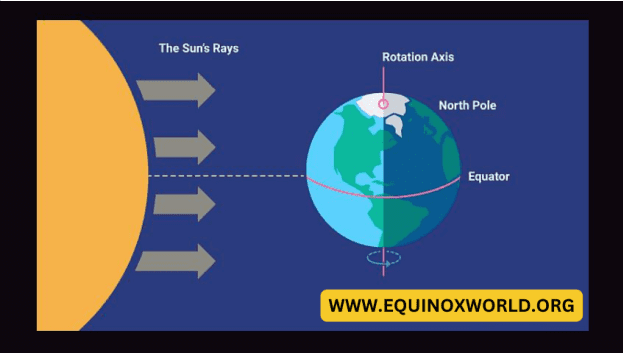What is Equinox ? Equinox is an astronomical event that occurs twice a year, marking the beginning of spring and autumn seasons. It is a fascinating occurrence that has intrigued scientists, astronomers, and ancient civilizations for centuries. In this article, we will explore the definition, types, significance, and observations of equinox.
Explanation of the occurrence of Equinox:
The equinox occurs when the sun is positioned directly above the equator, resulting in equal hours of daylight and darkness. It is important to note that the earth’s axis is tilted at an angle of 23.5 degrees, and as the earth rotates around the sun, this tilt causes the variation in seasons. During the equinox, the tilt of the earth’s axis is perpendicular to the sun, resulting in the equal distribution of light and darkness.
Types of Equinox:
There are two types of equinox: the March Equinox (Vernal Equinox) and the September Equinox (Autumnal Equinox). The March Equinox occurs around March 20th or 21st, marking the beginning of spring in the northern hemisphere and autumn in the southern hemisphere. The September Equinox occurs around September 22nd or 23rd, marking the beginning of autumn in the northern hemisphere and spring in the southern hemisphere.
March Equinox (Vernal Equinox):
The March Equinox is also known as the Vernal Equinox and is celebrated as the first day of spring in the northern hemisphere. During this time, the sun rises due east and sets due west, and the day and night are almost equal. The Vernal Equinox is considered a time of renewal, new beginnings, and growth, as the earth awakens from the long winter sleep.
September Equinox (Autumnal Equinox):
The September Equinox is also known as the Autumnal Equinox and marks the beginning of fall in the northern hemisphere. During this time, the sun sets due west and rises due east, and the day and night are almost equal. The Autumnal Equinox is considered a time of harvest, gratitude, and letting go, as the earth prepares for the winter season.
Equinox explain with diagram
A diagram of the equinox can help to visualize this phenomenon. The diagram typically shows the Earth as a circle with a tilted axis, with the Sun at the center. The equator is shown as a line that bisects the circle, and the poles are shown at the top and bottom.
During the equinox, the Sun appears to be directly above the equator. In the diagram, this is shown as a line that passes through the center of the Earth and is perpendicular to the plane of the equator. This line is known as the celestial equator, and it is an imaginary circle on the celestial sphere that corresponds to the Earth’s equator.
The celestial sphere is an imaginary sphere that appears to surround the Earth, with the stars and other celestial objects projected onto its surface. In the equinox diagram, the celestial sphere is typically shown as a larger circle that encompasses the Earth and the Sun.
The position of the Sun relative to the celestial sphere changes over the course of a year, as the Earth moves in its orbit around the Sun. During the equinox, the Sun appears to be moving along the ecliptic, which is the apparent path that the Sun takes across the sky over the course of a year. The ecliptic is tilted at an angle of approximately 23.5 degrees relative to the celestial equator
In the equinox diagram the position of the vernal equinox is also shown. This is the point on the ecliptic where the Sun appears to cross the celestial equator from south to north. This point is used as the reference point for the celestial coordinate system, which is used by astronomers to locate celestial objects in the sky.
Overall, the equinox is a fascinating astronomical event that has significant cultural and symbolic meaning for people around the world.
Significance of Equinox:
The equinox has both cultural and astronomical significance. Many cultures and religions around the world celebrate the equinox as a time of renewal, rebirth, and spiritual awakening. The equinox has also been used as a marker for agricultural and seasonal activities, such as planting, harvesting, and migration.
From an astronomical perspective, the equinox marks the beginning of a new season and a change in the earth’s tilt, which affects the amount of daylight and darkness in different regions of the world. It is also an important event for astronomers, who use the equinox to calculate the exact position of the earth in its orbit around the sun.
How Equinox is observed:
The equinox is observed in different ways around the world. Astronomers use special instruments to track the position of the sun and the earth during the equinox. Some cultures celebrate the equinox with festivals, feasts, and religious ceremonies, while others mark the occasion with rituals, meditation, and reflection. The equinox is also a popular time for outdoor activities, such as hiking, camping, and nature walks.
Importance of understanding Equinox:
Understanding equinox is important for several reasons. From a scientific perspective, equinox helps us understand the earth’s position in its orbit and the changing seasons. From a cultural perspective, equinox helps us appreciate the diversity of beliefs and traditions around the world. Finally, understanding equinox can help us connect with nature, reflect on our own personal growth and transformation, and appreciate the beauty and wonder of the natural world
September Equinox (Autumnal Equinox)
The September Equinox, also known as the Autumnal Equinox, occurs around September 22nd each year in the Northern Hemisphere. During this time, the Sun appears to move southward, crossing the celestial equator and moving into the southern hemisphere. This results in the length of daylight hours becoming shorter and the temperature becoming cooler in the Northern Hemisphere.
The Autumnal Equinox has been celebrated by various cultures throughout history as a time of harvest and transition. In many parts of the world, it marks the beginning of the fall season and is associated with activities such as apple picking, pumpkin carving, and hayrides.
In addition to its cultural significance, the Autumnal Equinox also has astronomical significance. It is the moment when the Sun is directly above the equator, which means that the length of day and night are almost exactly equal all over the world. This phenomenon is known as equilux, and it only occurs twice a year at the Equinoxes.
Significance of Equinox
The Equinox has significant cultural and astronomical importance. Historically, it has been celebrated as a time of harvest, transition, and renewal. Many cultures around the world have celebrated the Equinox with festivals and rituals, such as the Mid-Autumn Festival in China and the Jewish holiday of Sukkot.
From an astronomical perspective, the Equinox marks the moment when the tilt of the Earth’s axis is neither inclined away nor towards the Sun, resulting in nearly equal amounts of daylight and darkness at all latitudes. This is significant because it allows astronomers to measure the exact positions of celestial bodies and to determine the length of a year.
How Equinox is Observed
The Equinox is observed in various ways, depending on cultural and scientific contexts. Astronomers observe the Equinox by measuring the position of the Sun relative to the celestial equator. They use this data to calculate the Earth’s axial tilt and to determine the length of a year.
Culturally, the Equinox is celebrated in many parts of the world with festivals, rituals, and gatherings. For example, in Japan, the Autumnal Equinox is celebrated with a three-day festival called Higan, during which families visit the graves of their ancestors and offer food and flowers. In the United States, the Autumnal Equinox is celebrated with the holiday of Thanksgiving, which is associated with harvest and gratitude.
In conclusion, the Equinox is a fascinating astronomical phenomenon that has significant cultural and scientific importance. By understanding the Equinox, we can appreciate the natural cycles of the Earth, celebrate its cultural significance, and measure the exact positions of celestial bodie






























